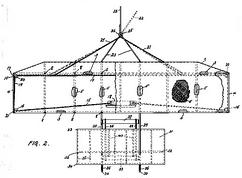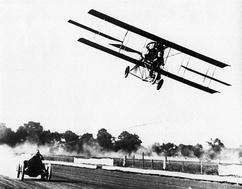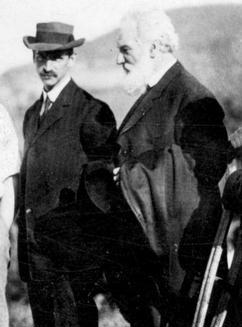|

 Up
Up 
 An Idea Whose
An Idea Whose
Time Had Come

(You are here.)



  Need
to Need
to
find your
bearings?
Try
these
navigation aids:
If
this is your first
visit, please stop by:
Something
to share?
Please:



|
|
Available in Française, Español, Português, Deutsch, Россию,
中文,
日本, and others.
 s
Walcott was slowly rebuilding Langley’s reputation, the Wright
brothers’ was being eroded. They had been international celebrities
and national heroes in 1909. But this changed when they filed a law
suit for patent infringement and began to ask royalties not just
from aircraft manufacturers, but also producers of aviation events
and even individual exhibition pilots. Pilots and plane-makers that
had once admired the Wrights now carefully followed the patent suits
and rooted against the brothers. Editorials appeared that condemned
the Wrights for their apparent greed and attempts to monopolize this
fragile new industry. To the general public, the Wrights were made
to look less like heroes and more like aspiring robber barons. s
Walcott was slowly rebuilding Langley’s reputation, the Wright
brothers’ was being eroded. They had been international celebrities
and national heroes in 1909. But this changed when they filed a law
suit for patent infringement and began to ask royalties not just
from aircraft manufacturers, but also producers of aviation events
and even individual exhibition pilots. Pilots and plane-makers that
had once admired the Wrights now carefully followed the patent suits
and rooted against the brothers. Editorials appeared that condemned
the Wrights for their apparent greed and attempts to monopolize this
fragile new industry. To the general public, the Wrights were made
to look less like heroes and more like aspiring robber barons.
This was the
situation in January of 1914 when a panel of three justices on the
United States Court of Appeals, Second Circuit upheld Judge Hazel’s
decision that the Curtiss Aeroplane and Motor Company to have
infringed on Patent No. 821,393 – the Wright brothers’ 1906 patent
on an aircraft control system. They also upheld his judgment that
the patent was entitled to “liberal interpretation” as it was the
grandfather or “pioneer” patent of the aviation industry.
It was an
electrifying decision for the entire aviation community; the
decision made it possible for Orville Wright (Wilbur was now
deceased) to create a patent monopoly on the airplane, the same as
Alexander Graham Bell had done with the telephone.
The Wright
Company’s board of directors met in New York immediately after the
decision was announced and proposed to do just that by hiring
William F. McComb – a confidant of the President Woodrow Wilson with
deep Democratic connections – to lobby the administration to buy
Wright aircraft. Orville balked. He did not want his company or the
aviation industry tied to a particular political party. He did not
want to manage a colossal manufacturing operation, nor did he want
to build one by bankrupting dozens of other companies. He began to
plot a way to shed himself of his corporate obligations and the
burden of the Wright patent. In the meantime, he let it be known
through the New York Times he was willing to work with any
aircraft manufacturer who was willing to pay 20% of the purchase
price to license their aircraft. This was the same percentage that
the Wright Company had charged Burgess and others who had licensed
their patents and designs – in short, it was business as usual.
Usual or not,
20% was a financial impossibility for most U.S. airplane
manufacturers prior to World War I; none of them were that
prosperous. Had it been enforced it would have put most of them out
of business, creating a monopoly through attrition. The news seemed
even worse for Curtiss, if that were possible. Other airplane
companies might be able to negotiate royalties and payments, but
there was too much bad blood between Orville Wright and Glenn
Curtiss for Curtiss to expect any mercy. Wilbur had run himself
ragged defending the Wright patent in court, then contracted typhoid
fever while on one of his many trips. His worn down physical
condition almost certainly made him more
susceptible and more likely to succumb to the disease, and the
Wright family held Curtiss indirectly responsible for Wilbur's
death.
That same month, Lincoln Beachey, a well-known aviator and a
stockholder in the Curtiss company, wrote to the Smithsonian and
asked for the loan of the remains of Aerodrome A. His
proposal was to restore the airframe, then mount a modern motor and
propellers and attempt to fly the old aircraft. It was not a new
idea; Bell, Chanute, and members of the U.S. Army had all suggested
something similar as early as 1906 – a good number of people in
Washington believed that the Aerodrome was not a failure; it simply
had been improperly launched. Walcott had actually written to
Curtiss about making another launch attempt prior to
Beachey’s
inquiry; it seemed a good initial project for the Langley
Aerodynamical Laboratory. Walcott turned Beachey down, but the
letter started a ball rolling.
Walcott could
not help but notice that news and editorials concerning the “patent
wars” had damaged Orville Wright’s reputation. The country had just
spent the better part of a decade trust-busting with President
Theodore Roosevelt to level the economic playing field for smaller
companies. The word “monopoly” had a stink about it, even if it was
supported by the courts. If the Aerodrome flew, it would show that
manned aircraft could have flown before the Wrights; their patent
had no right to pioneer status, and the suit would go back to the
courts. Not only would Langley be rehabilitated; the Smithsonian
would be seen as having saved the aircraft industry. It might be the
big win needed to procure some serious funding for the Langley
Aerodynamical Laboratory
Not long
afterwards, Walcott invited Curtiss to bring one of his new flying
boats to Washington for Langley Day – 6 May 1914. Curtiss, who was
aware of Beachey’s proposal, replied that he would rather restore
and fly the Aerodrome. There was a series of phone calls between
Curtiss, Bell, and Walcott as the project began to take shape. There
would be two separate missions, the first to show that the 1903
Aerodrome was airworthy and the second to investigate the properties
of the tandem-wing configuration. On March 25, Walcott told Bell
that Curtiss could reproduce the Aerodrome for $2000. It was a
bargain-basement estimate; it's almost certain that Curtiss proposed
such a low cost because he stood to gain so much from the project.
Then Bell and Walcott discussed whether it was proper for the
Smithsonian to fund the experiment, given its possible commercial
impact. To avoid that hornet’s nest, Walcott volunteered $1000 of
his own money and Bell offered to chip in the rest.
On March 30,
Walcott, Bell, and Curtiss met at Bell’s home in Washington. Walcott
wanted the Aerodrome replica ready to fly by Langley Day – May 6,
1914. Curtiss could not guarantee that he could get it done that
quickly, and Walcott suggested it might be faster to rebuild the
original Aerodrome. After all, the central frame was ready to go; it
had been repaired by Charles Manly, Langley’s assistant, before it
was stored. Bell objected, arguing that the 1903 Aerodrome A
was a valuable historic artifact. But technically it was not; the
Aerodrome was still the property of the U.S. Army and some members
of that Army had indicated that they would like to see the machine
fully tested. Walcott prevailed, expedience was paramount, and on
April 2 the Smithsonian shipped the original Aerodrome airframe to
Curtiss Aeroplane and Motor Company in Hammondsport, New York. This
was followed by the original engine several days later. All parties
agreed that this project should proceed in confidence, with no
announcement. The Smithsonian Board of Regents was never consulted
or asked to approve these actions, although Bell was a member of
this board.
|

Although the Wright patent was simply titled "Flying Machine," it
was specifically concerned with aircraft controls – the
control surfaces and the manner in which these surfaces were moved.
These made it possible to navigate the airplane, which in turn made
it a practical form of transportation.

Lincoln Beachey in the cockpit of his Curtiss-built "Beachey Special
Looper."

Beachey racing Barney Oldfield, a popular race car driver, at an
exhibition. The reason that Walcott turned Beachey down may have
been that Beachey was too much of a showman and Walcott wanted the
Aerodrome flights to have the appearance of a serious scientific
investigation.

The Aerodrome airframe, top view

The Aerodrome airframe from the side. This was the portion of the
aircraft that Many restored in 1904 before the machine was put in
storage.

Glenn Curtiss (left) with Alexander Graham Bell (right) and other
members of the Aerial Experiment Association (AEA), standing beside
the White Wing, one of several airplanes the group built in 1907,
1908, and 1909. Bell had introduced Curtiss to aeronautical
engineering and in many ways considered Curtiss to be a protégé.
|